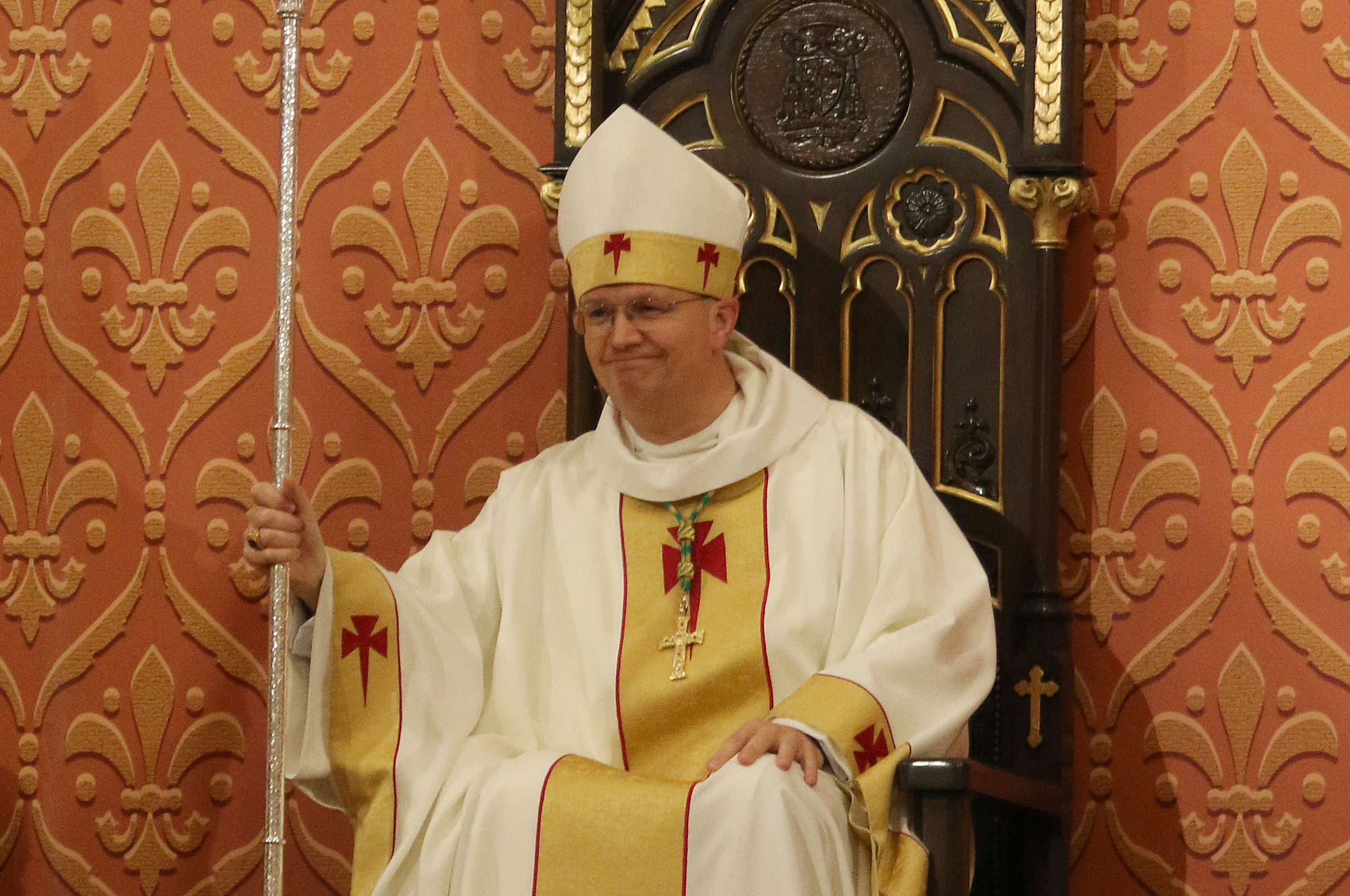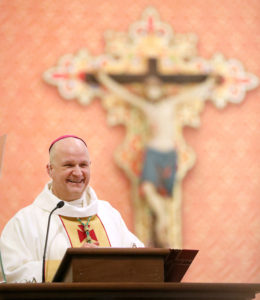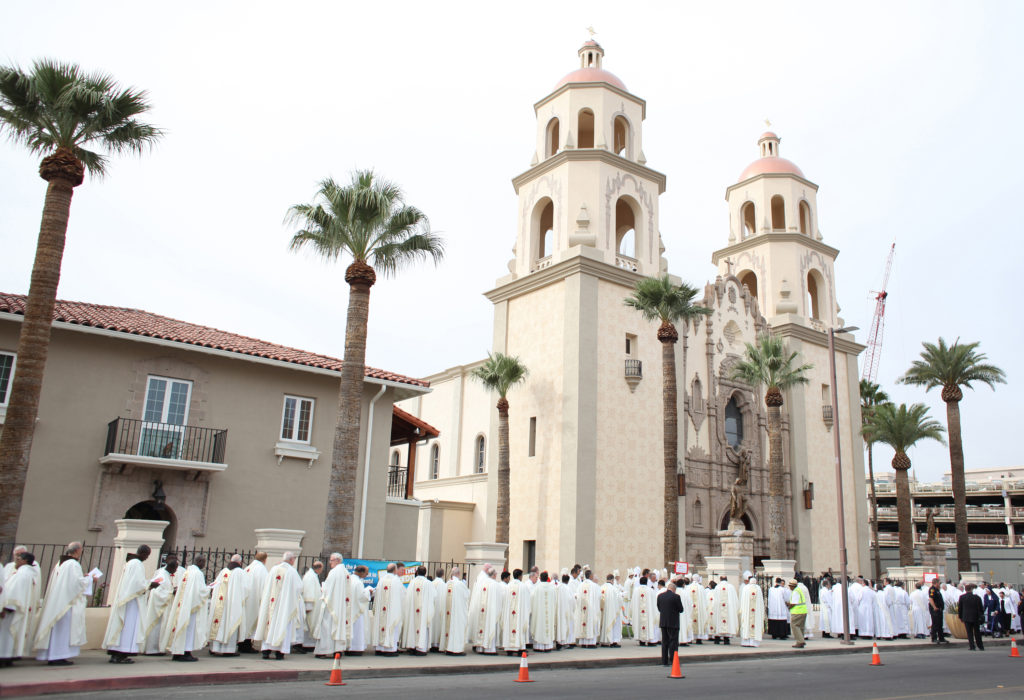
By Michael Brown
Catholic News Service
TUCSON (CNS) — Using his installation Mass homily to launch his episcopacy as the seventh bishop of Tucson, Bishop Edward J. Weisenburger laid out as a blueprint for ministry the day’s Gospel reading about Jesus’ call to the disciples as friends, not slaves.
“Let us be in friendship with all, for surely that is the way love grows, the kingdom is built and the great Diocese of Tucson will step into its next age. Brothers and sisters, let the friendship begin,” the bishop said.
The Nov. 29 installation was the last step in the transfer of leadership that began Oct. 3 with the announcement by Pope Francis that he had accepted the resignation of Bishop Gerald F. Kicanas, who served the diocese for 16 years, first as coadjutor bishop under Bishop Manuel Moreno and then as Tucson’s sixth bishop.
When he was named Bishop Kicanas’ successor, Bishop Weisenburger was bishop of Salina, Kansas. He had headed that diocese since 2012.
During his tenure in Tucson, Bishop Kicanas became known for his advocacy on behalf of the poor, immigrants and cooperation with religious and civic leaders, and was beloved by Catholics throughout southern Arizona.
That love was evident in St. Augustine Cathedral as Bishop Kicanas was repeatedly applauded, including a minute-long standing ovation during Bishop Weisenburger’s homily.
“I cannot let the day pass without perhaps one final time in this setting to say thank you to that magnificent shepherd who for 16 years, as explained and poured out in the Gospel, given his life in sacrificial love for us, my own thanks and the thanks once again of our people to Bishop Kicanas,” Bishop Weisenburger said, leading to the applause.
Bishop Weisenburger begins homily by asking everyone to thank Bishop Kicanas, followed by standing ovation that brought Kicanas to tears #Tucson pic.twitter.com/ZjVUk1e5Q0
— Angelica Carrillo (@acarrillonews) November 29, 2017
The day belonged to Bishop Weisenburger, and he used the homily to build on the legacy of his predecessor in embracing the poor and accompanying those overlooked by society, using the example of the Eight Beatitudes as his model.

Jesus intended his message to “turn everything upside down,” the bishop said. “It’s not the rich, the healthy, the happy and the favorite who are among His most chosen ones. It’s the poor, the suffering, the neglected and the humble — not the humble by choice, but the humble by necessity. He turns everything upside down and it gets Him in a lot of trouble.”
“Until we begin to turn things upside down in our minds and look at it very differently, and embrace the world as He did in this topsy-turvy way, I am not sure we can authentically call ourselves His friends,” he said.
The bishop then focused on two elements of the Gospel: That Jesus chose us, and that we were chosen as friends.
“When you consider all the world’s great religions, all of which contain some truth, it is almost always humankind’s literal or figurative struggle up the mountain to encounter God. It is our energy, our effort to encounter and find God,” the bishop said. “Jesus flips it upside down. He said, ‘No, it’s God in Me and with perfect love, Who has been looking out for you, seeking you, running after you forever.’”
“As I step into this new role, let it be one of holy friendship,” he added. “This celebration this day is not first and foremost about me. It really is a celebration of the Church and even in its best sense, what you and I are to be — together — for the Church and for the world.”
Bishop Weisenburger exhibited humility and humor during his homily, preached initially in Spanish, followed by English. The bishop studied Spanish as a seminarian but has apologized for his skills.
After delivering the homily in Spanish, reading a translation that he saw had been prepared for him, he quipped: “For those of you who don’t speak Spanish, I bet that sounded good. And for those of you who do,” the bishop made the penitential gesture of striking his breast three times, “I’ll get better.”
The installation was attended by more than two dozen bishops, including Bishop Thomas J. Olmsted of Phoenix; Cardinal Roger M. Mahony, retired archbishop of Los Angeles; Archbishop Christophe Pierre, papal nuncio to the U.S.; and Archbishop John C. Wester of Santa Fe, New Mexico, who was the main celebrant of the Mass until Bishop Weisenburger received his crosier, or staff, and took possession of the cathedra, or bishop’s chair.

“Because I served as a bishop in Kansas (Wichita) before coming to Phoenix, I am happy to welcome another bishop from my home state to serve in Arizona,” said Bishop Olmsted. “The celebration was a beautiful expression of the great love of Jesus for His Church and the richness of our Catholic faith, handed down from one generation to another. I look forward to working with Bishop Weisenburger.”
About 1,100 priests, family and friends from Kansas and Oklahoma, ecumenical and civic leaders, and hundreds of Catholics from parishes throughout the diocese filled the cathedral.
It was a cool scene and sound Weds. outside the bishop's installation at the San Agustin cathedral in downtown Tucson. pic.twitter.com/8VGijPrIqE
— Tim Steller (@senyorreporter) November 30, 2017
The Franciscans & Lasallians with the whole Church celebrating the Installation Mass of our new Bishop of Tucson! pic.twitter.com/oDj5Rbi11Q
— Sister Mary Ann (@SisterMaryAnn) November 30, 2017
Brown is managing editor of CATHOLIC OUTLOOK, newspaper of the Diocese of Tucson.






